I guess we arrived just in time to witness the Great Paris Heat Wave of 2015. The thermometer has been gaining a few degrees every day since we got here…Tuesday was in the mid 30s, Wednesday in the upper 30s.
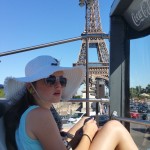
![]()
![]() Tuesday was spent on the top deck of various tour buses as we explored the inner parts of Paris. Paris was on the verge of a heat wave as we arrived and I’m not sure the city was totally prepared for it. Tuesday saw us heading for the top deck on the assumption that the breeze would bring us relief from the 35 degree sun. In reality, we were on the wrong side of the frypan, slowly sizzling as the bus gently rocked us to make sure were cooking evenly.
Tuesday was spent on the top deck of various tour buses as we explored the inner parts of Paris. Paris was on the verge of a heat wave as we arrived and I’m not sure the city was totally prepared for it. Tuesday saw us heading for the top deck on the assumption that the breeze would bring us relief from the 35 degree sun. In reality, we were on the wrong side of the frypan, slowly sizzling as the bus gently rocked us to make sure were cooking evenly.
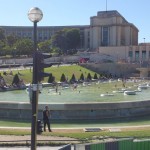
![]() Normally the fountain at Trocadero is a thing one admires from a distance but the heat wave has people crossing the lawn and shedding clothes to seek some relief from the heat. Still, I see men of all ages on bikes, scooters or motorbikes mending their way through the streets barely breaking out into sweat as I trudge along, my hair beneath my cap dripping with perspiration. I can only pity the poor soldiers and police officers who wear body armour and tactical gear and long-sleeved clothing…
Normally the fountain at Trocadero is a thing one admires from a distance but the heat wave has people crossing the lawn and shedding clothes to seek some relief from the heat. Still, I see men of all ages on bikes, scooters or motorbikes mending their way through the streets barely breaking out into sweat as I trudge along, my hair beneath my cap dripping with perspiration. I can only pity the poor soldiers and police officers who wear body armour and tactical gear and long-sleeved clothing…
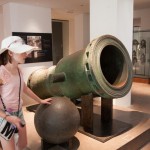
Our first stop on Wednesday (Day 2 of the heat wave) was the Musée des invalides — it translates to Museum of the Wounded since part of the complex is also a hospital. Napoleon was one of the first to honour veterans and the wounded. The first part of the museum consists of the Royal Collection gathered from all the monarchs before the Revolution. This is an amazing (and plentiful) collection of arms and armour from the 12th to the 19th century. Included are the suits of armour worn by kings and princes as well as an amazing array of flint-lock pistols and long guns, arquebuses, arbalettes, arrows and quivers, chain mail, scabbards and all manner of swords as well
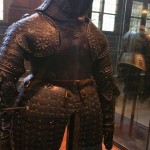
One of the things that struck us at the museums was how attitudes had evolved over the generations. Certainly, given the attention to details on all the weapons we saw, violence and carnage was part of everyday life. But the other aspect that seems to have been set aside in the race towards modern times is what Erin calls the Peacock factor. It seems there was a time when men “strutted their stuff” like the males of other species — I am reminded of the period when cod-pieces we fashionable for instance.
But perhaps men were comfortable strutting like peacocks only because their manliness was never questioned? Take this man,Le duc d’Enghien, for instance. I`m sure that, as a conqueror in the mid-17th century, he was likely dressed like this. Yet, when he returned home and it was time for posterity to record his victory, he chose to be depicted like this. Now I just can`t imagine some modern-day American commander in Kabul changing into this kind of gear to accept the surrender of an ISIL rebel. But hey, maybe it’s time?
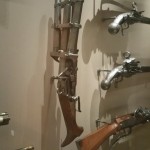
Anyways, the museum is a fascinating place. Canada’s war museum has much larger artifacts (they couldn’t fit planes and tanks in the Musée des invalides even if they wanted). Early weapons were works of art, finely sculpted wooden gunstocks, intricately etched blades, decorated gun barrels. Some were ceremonial while others saw battle and were worn by nobility.Then, getting into the more modern section we can see that weapons and uniforms get more functional…and more efficient.
 The World War 1 and 2 sections are extensive and show the uniforms of just about every ally and enemy France has had. There are many of them. There are also explanations of what started various wars and skirmishes. And an excellent exhibition on Churchill and General Charles de Gaulle that really explains the importance of these two gentlemen in shaping modern Europe.
The World War 1 and 2 sections are extensive and show the uniforms of just about every ally and enemy France has had. There are many of them. There are also explanations of what started various wars and skirmishes. And an excellent exhibition on Churchill and General Charles de Gaulle that really explains the importance of these two gentlemen in shaping modern Europe.
 The next part was the visit to Napoléon’s Tomb. This is no ordinary place. He died in St. Helens but the King ordered his body brought to Paris and had a tomb built behind the church at Saint-Louis within the military complex. The building is indescribable. Ornate painted ceilings, marble floors and columns, gold everywhere.
The next part was the visit to Napoléon’s Tomb. This is no ordinary place. He died in St. Helens but the King ordered his body brought to Paris and had a tomb built behind the church at Saint-Louis within the military complex. The building is indescribable. Ornate painted ceilings, marble floors and columns, gold everywhere.
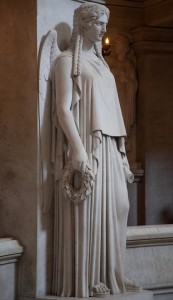
His remains rest in a huge sarcophagus in the centre of a large ring. Stone angels twice the height of humans, their eyes transfixed to the sarcophagus, circle the resting place as though disbelieving in his demise and hopeful of a resurrection (unlikely since the Brits incinerated his remains before returning them to Paris…`”Ooops, my bad old chap”). The effect is both eerie and restful. Here tension co-exists reluctantly with serenity. He died at 51, in prison in a foreign land. But he returned triumphant in his death and probably the most revered leader France has known.